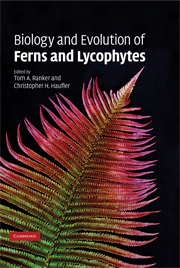Book contents
- Frontmatter
- Contents
- List of contributors
- Preface
- Acknowledgments
- Part I Development and morphogenesis
- Part II Genetics and reproduction
- Part III Ecology
- 8 Phenology and habitat specificity of tropical ferns
- 9 Gametophyte ecology
- 10 Conservation biology
- 11 Ex situ conservation of ferns and lycophytes – approaches and techniques
- Part IV Systematics and evolutionary biology
- Index
- References
8 - Phenology and habitat specificity of tropical ferns
Published online by Cambridge University Press: 11 August 2009
- Frontmatter
- Contents
- List of contributors
- Preface
- Acknowledgments
- Part I Development and morphogenesis
- Part II Genetics and reproduction
- Part III Ecology
- 8 Phenology and habitat specificity of tropical ferns
- 9 Gametophyte ecology
- 10 Conservation biology
- 11 Ex situ conservation of ferns and lycophytes – approaches and techniques
- Part IV Systematics and evolutionary biology
- Index
- References
Summary
Introduction
The focus of this chapter is two aspects of fern sporophyte ecology: phenology and habitat specificity. I define phenology as the study of the periodicity of biological processes caused by intrinsic factors (hormones, circadian clock) or triggered by extrinsic, environmental factors, mainly rainfall, temperature, and photoperiod, or some combination of those elements. Habitat specificity is defined as the biotic and abiotic conditions that favor the development and, consequently, the presence and abundance of fern species on a spatial scale.
Historical summary
Descriptive treatments considering ecological aspects of ferns and lycophytes have been organized geographically (Christ, 1910) and by vegetation types and/or growth forms (Holttum, 1938; Tryon, 1964; Page, 1979a). The latter organization is followed for the two ecological issues treated within this chapter, starting with terrestrial species, followed by rheophytes (fluvial plants), lithophytes (rock plants), epiphytes, and climbers. All other growth forms (e.g., hemi-epiphytes, mangrove ferns) are either treated marginally within the nearest group (e.g., tree ferns within terrestrial ferns, mangrove ferns within rheophytes) or omitted because of lack of information.
Holttum (1938) observed that ferns and lycophytes are rarely dominant in any plant community. His statement that most vegetation types would not be greatly modified if all ferns were removed reflects the low importance he accorded ferns in a functional context within tropical forest ecosystems. In fact, we simply do not understand the ecological importance of ferns, because few studies have addressed this issue. Page (1979a) presented an opposite point of view.
- Type
- Chapter
- Information
- Biology and Evolution of Ferns and Lycophytes , pp. 201 - 221Publisher: Cambridge University PressPrint publication year: 2008
References
- 26
- Cited by



